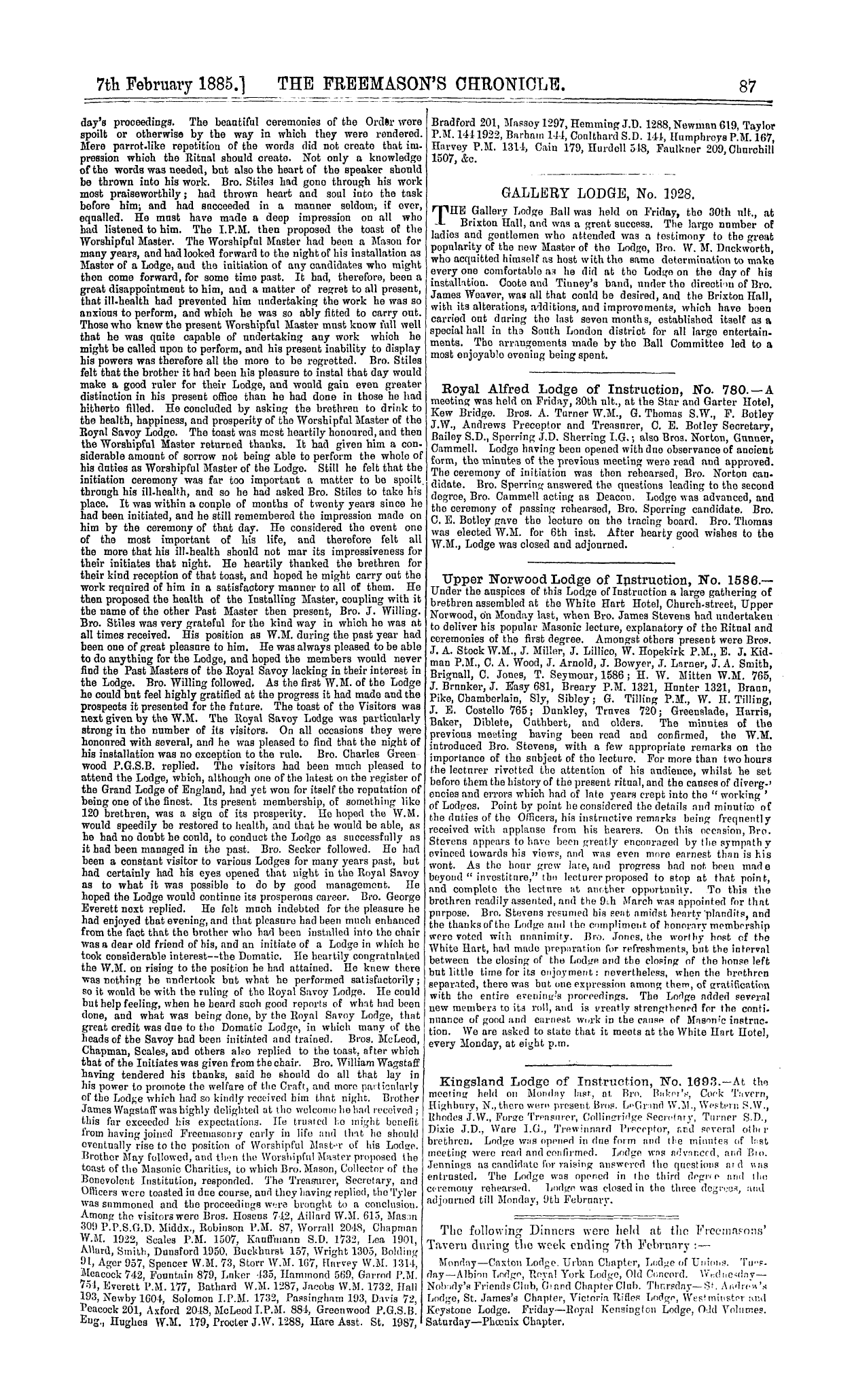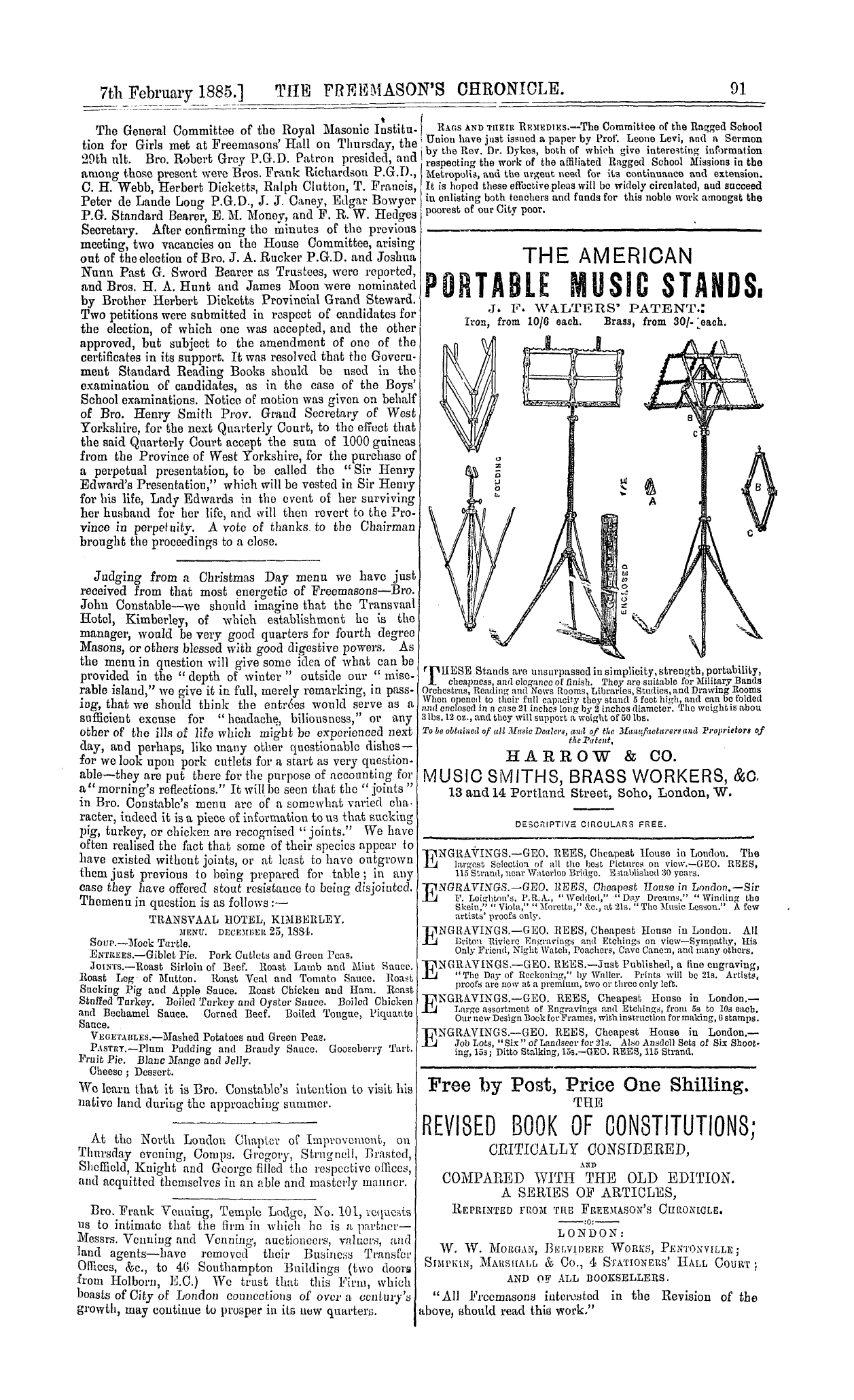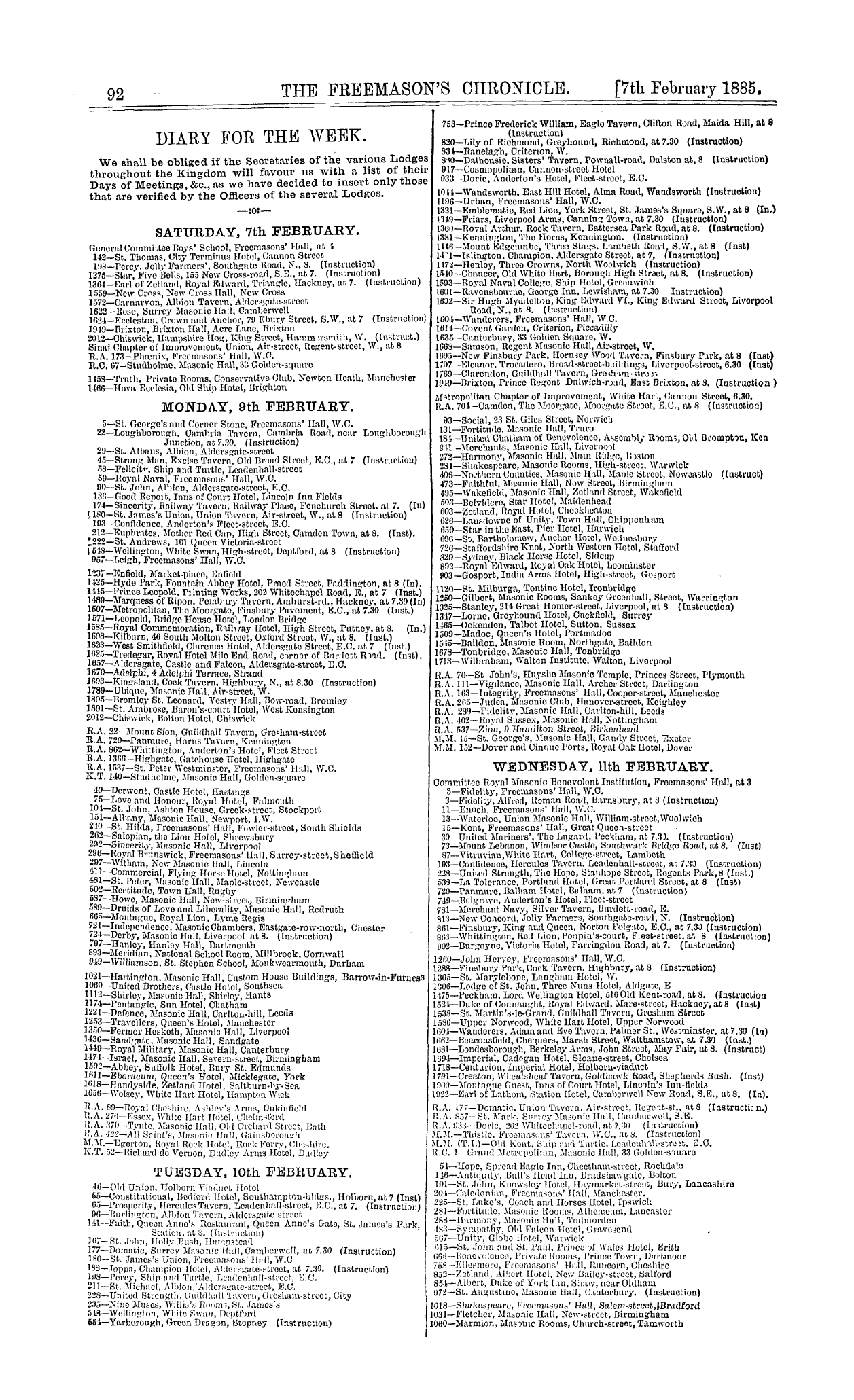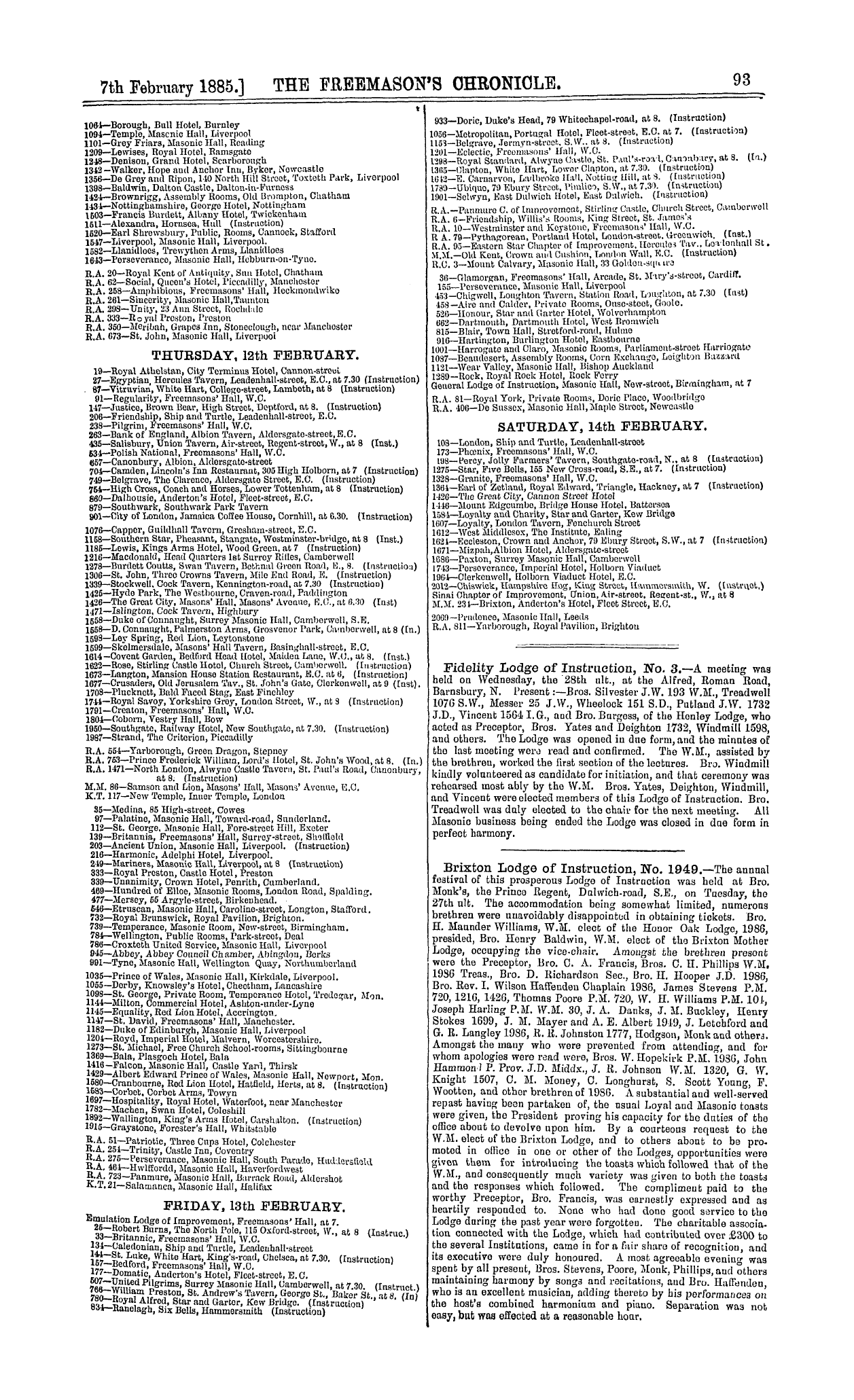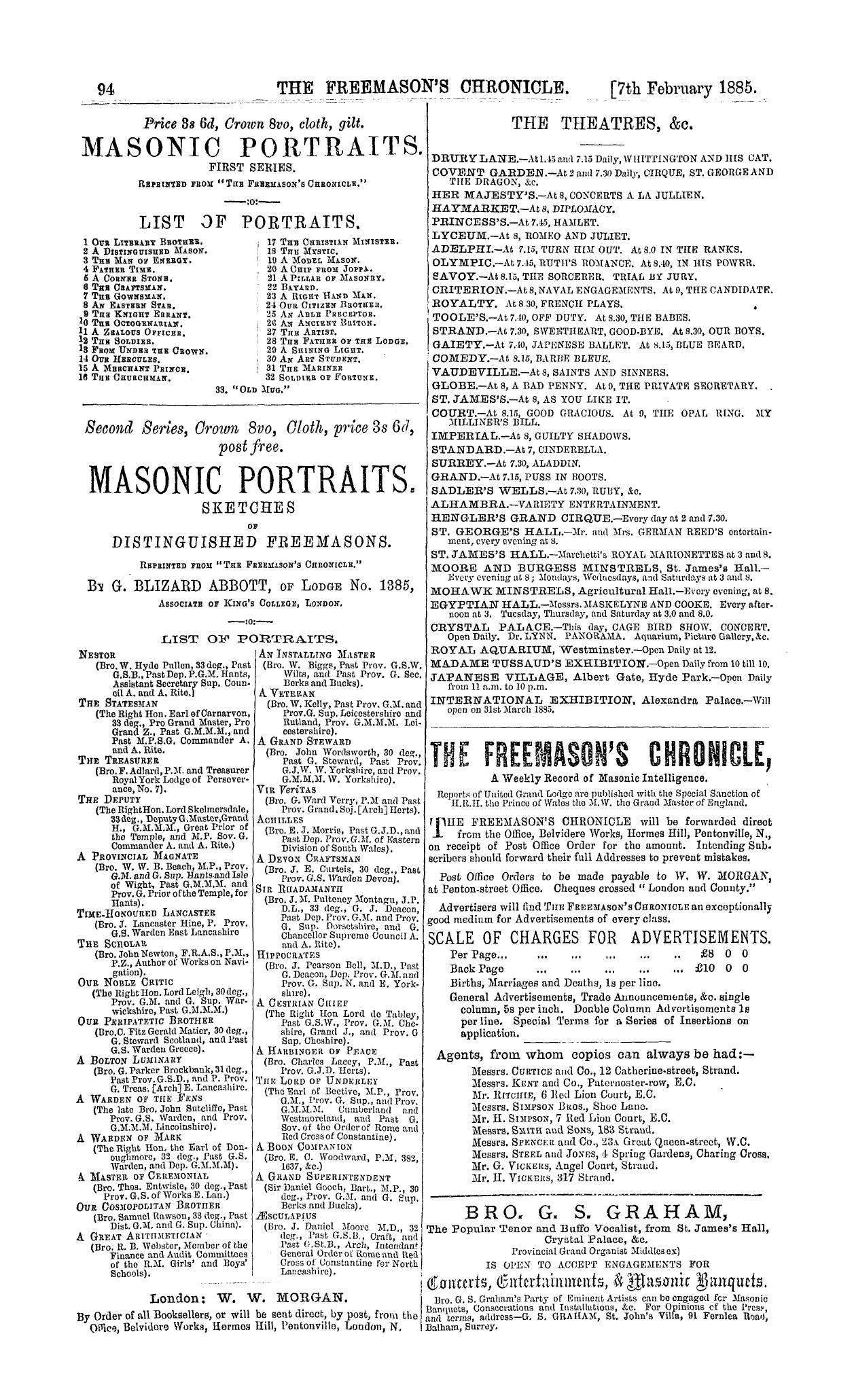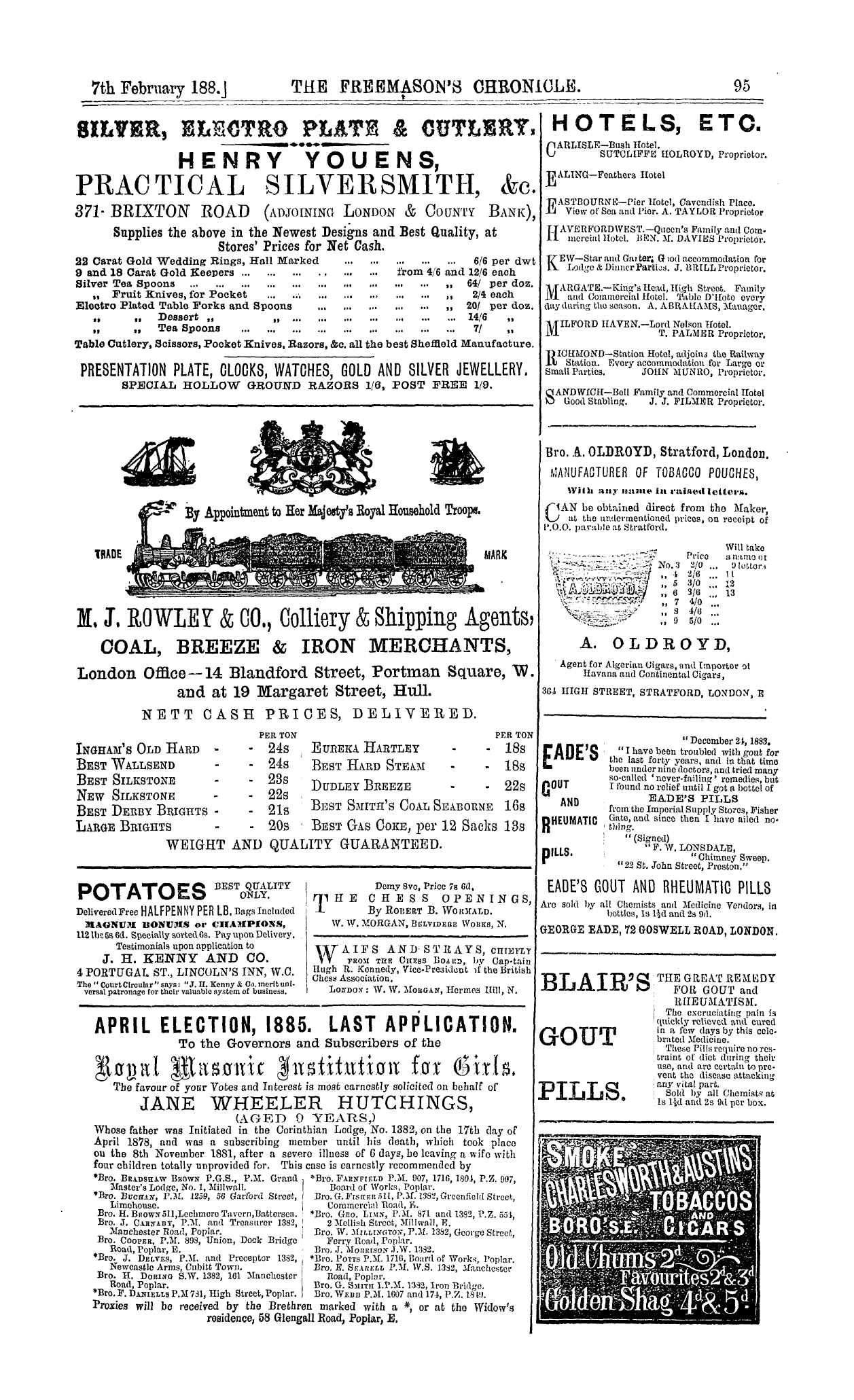-
Articles/Ads
Article THE THEATRES. Page 1 of 1 Article COURT. Page 1 of 1 Article COURT. Page 1 of 1 Article ST. GEORGE'S HALL. Page 1 of 1
Note: This text has been automatically extracted via Optical Character Recognition (OCR) software.
The Theatres.
THE THEATRES .
VAUDEVILLE . FOR any of oar readers who may need a little bracing after the rather lowering treatment they may have experienced at Dr . Wingfield ' s sanatorium at St . James ' s , we could recommend nothing more likely to restore " tone " than a visit to tho Vaudeville . " Saints and Sinners , " with the sharp contrasts of the virtues aud vices of
pitiless real life , retire from the stage and make room for their successors , creatures so amusing , so full of vigorous , delightful absurdity , thafc we accept as perfectly natural phenomena their wildest proceedings . The new play " Loose Tiles " is , perhaps , not very new in the matter of plot . We have heard of one produced at the Adelphi a
good many years ago , in which the action is made to pivot on the mistaking a private house for a lunatic asylum . Terence , two thousand years gone by , found all the best plots anticipated , so what can tnodevns do ? Let us have tho old plots , if only they come decked
with fresh fancies and alive with the life we breathe , as of old they were animated by contemporary vitality . No matter where Mr . Hurst has gathered the stones , so that he has the architect ' s skill to raise , if not a high art temple , afc least a pleasant wayside altar , to kindly old Momus .
" Story ? Lord bless you ! Thero is none to tell , sir . " Only the volatile young horo , Charlie Heathcote ( Mr . H . Neville ) , happens to be the son of worthy Dr . Heathcote , director of a private asylum for lunatics . Charlie has been to seek his fortune in Australia , and has just returned , as the curtain rises , accompanied by his
amiable and diffident Cockney friend , Bob Twitters ( Mr . T . Thorne ) . They intend a pleasant surprise to the doctor , and arrive at his house not knowing he has made it over to a Mr . Crnmbley , who has set np a select boarding establishment there . Charlie and his friend interview Mrs . Crnmbley ( Miss Giffard ) , and arouse her suspicions by
their demand for the doctor and the matron , whilst they regard her as one of the lunatic patients , and consider her brusque replies proof of her mental condition . " Wo must humour them , " says Charlie . " Ob , we'll humour them , " says Bob , beginning to shake in every limb . Presently enters Maria Snatters ( Miss Sophio Larkin ) a
susceptible elderly spinster . Charlie introduces his friend , the ladv evinces a suddenly intense interest in him , with that almost pathetic earnestness which makes the most preposterous caricature become a portrait from life when interpreted by Miss Larkin . The house shook with laughter as the scene proceeded , through a crescendo of
misunderstandings to tho moment when Maria , who has sent to Trueiitts for a coiffeur , is deluded by the mischievous Charlie into tho belief that Bob is an ardent admirer , disguised as the hairdresser ' s assistant . He , in abject fright of the supposed lunatic , allows himself to be dragged away by her . In the second act there is an equally
effective scene for Mr . Thorne , when , in his great game oFecai'te with an irascible old boarder ( Mr . Lesfcocq ) , Bob feels his very life may be Bacrificed to the chances of the game . Quite speechless , but with an eloquence beyond words , ho makes tho horror of the situation almost tragic . The sentimental interest is provided by Laura Myrtle ( Miss
C . Grahame ) , with whom Charlie falls in love , whilst in sore distress , believing the " poor thing " is out of her mind . The reader will see that the play must owe its value to the actors , but the motif is a capital one in such capable hands . Mr . Thorne , Mr . Neville , and Miss Larkin have rarely found better material for the vis comica
and the minor characters aro harmoniously completed by their clever coadjutors . We must , however , protest against Mr . Lestocq's coarse sketch of Tozer . It is completely out of drawing . Mr . Lestocq has
plenty of talent , if he would but discipline it . We congratulate Mr . Thorne on this newest success , and the public for the enjoyment it has in store . The curtain fell on the last act amid enthusiastic plaudits and calls for the anthor .
Court.
COURT .
WE can scarcely congratulate the management of the Court Theatre on the happiness of their choice , exemplified in the " light piece , " played for the first time on a Wednesday afternoon , and now appearing in the evening bill . "The Opal Ring , " by G . W . Godfrey , is the second appearance in an English form of Octave
Feuillet ' s " Peril en la Demeure . " The earlier version , by Tom Taylor , which appeared 26 years ago , was interpreted by Alfred Wigan , as the husband , John Billington , who in those days made a graceful Lothario , Miss Simms the femme incomprise , and Mrs . A . Wigan , to whom the honours of the evening chiefly fell . With such
a cast a very weak play would have its weak points effectually disguised for the time , and now , in the new version , by our clever dramatist , Mr . Godfrey , the fictitious sentiment and morbid sentimentality of the story gains vigour and reality by the admirable acting of its exponents . The story is simple enough . There is
Monsieur , the husband ( John Clayton ) , Madame , la femme incomprise ( Miss Terry ) , the " third person " ( Mr . Conway ) . The husband , though much attached to his wife , devotes his chief time and thought to his profession , and in his constant occupations never dreams of the dangers to which the wife may be exposed from the
fascinations of a mashing attache , and want of interest in anything but her own nerves and sentimental yearnings . Miss Marion Terry contrives to make this exasperating simpleton interesting by the sincerity and grace of her acting . Mr . Conway has a still harder
task with the objectionable attache , Harold Rivers , who , notwithstanding Sir George ' s friendship for himself and his mother , Mrs . Rivers , makes love to Sir George ' s wife , with an ardenb belief in the generous disinterestedness of the proceeding . Mrs . Rivers ( Miss Lydia Foote ) has discovered he is in love where he ought not to be ,
Court.
but unsuspicious of the actual object , confides her trouble to Sir George , and to prevent a rendezvous begs Sir George to take charge of the young gentleman till a certain hour . Sir George , busy with a despatch , finds the presence of a nervous young gentleman fidgeting the furniture and pictures very trying , and takes him off to Lady
Carteret s boudoir , charging her to keep the prisoner in safe ous . tody . Here was a fine opportunity , and it was well employed by Mr . Conway and Miss Terry . Her nervous anger afc her admirer's intrusion , with the underlying fear of her own weakness , was rendered with much delicacy , whilst the lover ' s embarrassment at ;
the interview being thus obtained , the evident complete and kindly trust shown by his chief , wakes compunction for a moment even in the soul of a masher . Bufc the better feeling does not last long . The old refrain , " Je t'adore " is about to have its usual result when the gods intervene in tho person of Mrs . Rivers . Exit the
masher , unseen , as he fondly supposes , by mamma . She , however , has seen him , and has learnt the secret . He had confessed au opal ring was to be a signal , though worn by an unconscious agent . She has noticed one on the hand of Sir Georgo , and thinking to forestal mischief , begs him to lend it her . Lady Carteret's emotion afc
seeing the opal on her friend s finger explains the mystery to the anxious mother . Here Miss Lydia Foote was able to hold the sympathy of the audience in wrapt attention till the end . As she stands forward to shield these reckless simpletons Sir George enters , with a letter unaddressed and unsigned , but actually written by the
attache , aud entrusted to Lady Carteret's maid for her mistress , but intercepted by Toler , a meddling old gentleman , and in perfect good faith and simplicity handed to Sir George . The mother and the wife stand aghast at the probable consequences of the discovery . In the original the mother foresees the inevitable duel . In the English
version the dishonour and disgrace of an unmasked intrigue ; and though tho poignancy of the former result is wanting , we forget ifc in tbe moral anguish of this pure and gentle woman . Afc first almost crushed by the impending misery , suddenly , to save the poor , repentant wife , her son , and his generous friend , finds a heroic
falsehood to explain tho letter . The curtain falls so soon that Sir George has no timo to sift the questionable evidence , and we hope the young folks may be wiser in future . Mr . Clayton has rarely played with greater delicacy and finish . The gentle irony , the kindliness and manly dignity of the diplomatist find perfect expression in
every touch and intonation . Mr . Cecil , in a quite episodical character ( Lord Toler ) , is Major Pendennis to the life ; a delightful etching after Thackeray . Miss Lydia Foote , as Mrs . Rivers , shows the sweet , ness and refinement so eminently her own ; but why should she disguise her pretty hair under that conventional yellow wig , and her own charming features beneath an unnecessary " make-up ?"
St. George's Hall.
ST . GEORGE'S HALL .
THESE graceful little dramatic aquarelle sketches at the St . George's Hall show no falling-off , either in merit or in the public appreciation . " Old Knockles " gives capital opportunity for Mr . A . Reed ' s quaint humour ; his make-up as an old fisherman is eminently real . Miss Fanny Holland creates no little enthusiasm by her graceful and artistic rendering of " There is a rare and
radiant land , " and Mr . A . Reed scores no less well with the salt water ditty , " Jack Bunt , he was a sailor . " Mr . Corney Gram ' s new musical sketch , " Backsheesh , " is in his most brilliant vein . He rattles through all the delights and tribulations awaiting the pilgrim
between London and Cairo ; the experiences of " Three in a stateroom , " the confidences of the intellectual spinster , whilst the lyric , " It is not so in Angleterre , " commanded an irresistible encore . The hall was crowded in every part on the night of our visit , and for those to whom the theatre is tabooed here is a delightful ombre du vrai .
NEW UNIVERSITY MEDICAL SCHOOL AT SYDNEY . —With the assist . ance of the New South Wales Government , a Medical School is to be established in connection with Sydney University , and plans for a suitable building , iu the Gothic style , have been prepared by the Colonial Architect . The length will be over 200 feet , with a depth
of 115 feet , and walls 60 feet high . Through the centre of the building there runs a large hall 13 feet wide , and out of it the tower rises to an altitude of 80 feet . In the main portion of the groundfloor are rooms for lecturers on pathology and medicine , an anatomical museum , medical class museum , and pathological , histological , and
private physiological laboratories . The right wing is set apart as a class-room for practical pathology , with smaller rooms for a materia medica museum , laboratory , and lecturer ' s room . In the left wing are provided rooms for chemical physiology , physiological class museum , instrument and balance-room , experimental physiology ,
physiological workshop , and a large room for the practical histological class . The upper floor is reached by staircases from either wing of the ground-floor , and by a lift from the basement . The dissectingroom is situate on the upper floor , to which the lift will bring the bodies as they are wanted for experiments . A large theatre of
anatomy , also one of surgery , and museum , each measuring 36 feet by 44 feet , surgical class room , surgical lecturer's room , midwifery class museum , midwifery lecturer ' s room , anatomy professor ' s room , anatomical laboratory , demonstrator of anatomy room , small theatre of anatomy , and prosectory , occupying the main portion of this floor
In the right wing there is a theatre of pathology and materia medica , and one of midwifery and medical jurisprudence , each 36 feet by 45 feet in measurement . The dissecting-room and theatre of physiology , measuring 51 feet by 41 feet each , are in the other wing . The
basement floor is set aside for quarters , students reading-room , coffee-room , injecting-room , medical jurisprudence lecturer ' s room , experimental physiology and pathology , large minto-tiled corridors , ten feet wide , running the whole length of the building . The estimated cost is £ 50 , 000 .
Note: This text has been automatically extracted via Optical Character Recognition (OCR) software.
The Theatres.
THE THEATRES .
VAUDEVILLE . FOR any of oar readers who may need a little bracing after the rather lowering treatment they may have experienced at Dr . Wingfield ' s sanatorium at St . James ' s , we could recommend nothing more likely to restore " tone " than a visit to tho Vaudeville . " Saints and Sinners , " with the sharp contrasts of the virtues aud vices of
pitiless real life , retire from the stage and make room for their successors , creatures so amusing , so full of vigorous , delightful absurdity , thafc we accept as perfectly natural phenomena their wildest proceedings . The new play " Loose Tiles " is , perhaps , not very new in the matter of plot . We have heard of one produced at the Adelphi a
good many years ago , in which the action is made to pivot on the mistaking a private house for a lunatic asylum . Terence , two thousand years gone by , found all the best plots anticipated , so what can tnodevns do ? Let us have tho old plots , if only they come decked
with fresh fancies and alive with the life we breathe , as of old they were animated by contemporary vitality . No matter where Mr . Hurst has gathered the stones , so that he has the architect ' s skill to raise , if not a high art temple , afc least a pleasant wayside altar , to kindly old Momus .
" Story ? Lord bless you ! Thero is none to tell , sir . " Only the volatile young horo , Charlie Heathcote ( Mr . H . Neville ) , happens to be the son of worthy Dr . Heathcote , director of a private asylum for lunatics . Charlie has been to seek his fortune in Australia , and has just returned , as the curtain rises , accompanied by his
amiable and diffident Cockney friend , Bob Twitters ( Mr . T . Thorne ) . They intend a pleasant surprise to the doctor , and arrive at his house not knowing he has made it over to a Mr . Crnmbley , who has set np a select boarding establishment there . Charlie and his friend interview Mrs . Crnmbley ( Miss Giffard ) , and arouse her suspicions by
their demand for the doctor and the matron , whilst they regard her as one of the lunatic patients , and consider her brusque replies proof of her mental condition . " Wo must humour them , " says Charlie . " Ob , we'll humour them , " says Bob , beginning to shake in every limb . Presently enters Maria Snatters ( Miss Sophio Larkin ) a
susceptible elderly spinster . Charlie introduces his friend , the ladv evinces a suddenly intense interest in him , with that almost pathetic earnestness which makes the most preposterous caricature become a portrait from life when interpreted by Miss Larkin . The house shook with laughter as the scene proceeded , through a crescendo of
misunderstandings to tho moment when Maria , who has sent to Trueiitts for a coiffeur , is deluded by the mischievous Charlie into tho belief that Bob is an ardent admirer , disguised as the hairdresser ' s assistant . He , in abject fright of the supposed lunatic , allows himself to be dragged away by her . In the second act there is an equally
effective scene for Mr . Thorne , when , in his great game oFecai'te with an irascible old boarder ( Mr . Lesfcocq ) , Bob feels his very life may be Bacrificed to the chances of the game . Quite speechless , but with an eloquence beyond words , ho makes tho horror of the situation almost tragic . The sentimental interest is provided by Laura Myrtle ( Miss
C . Grahame ) , with whom Charlie falls in love , whilst in sore distress , believing the " poor thing " is out of her mind . The reader will see that the play must owe its value to the actors , but the motif is a capital one in such capable hands . Mr . Thorne , Mr . Neville , and Miss Larkin have rarely found better material for the vis comica
and the minor characters aro harmoniously completed by their clever coadjutors . We must , however , protest against Mr . Lestocq's coarse sketch of Tozer . It is completely out of drawing . Mr . Lestocq has
plenty of talent , if he would but discipline it . We congratulate Mr . Thorne on this newest success , and the public for the enjoyment it has in store . The curtain fell on the last act amid enthusiastic plaudits and calls for the anthor .
Court.
COURT .
WE can scarcely congratulate the management of the Court Theatre on the happiness of their choice , exemplified in the " light piece , " played for the first time on a Wednesday afternoon , and now appearing in the evening bill . "The Opal Ring , " by G . W . Godfrey , is the second appearance in an English form of Octave
Feuillet ' s " Peril en la Demeure . " The earlier version , by Tom Taylor , which appeared 26 years ago , was interpreted by Alfred Wigan , as the husband , John Billington , who in those days made a graceful Lothario , Miss Simms the femme incomprise , and Mrs . A . Wigan , to whom the honours of the evening chiefly fell . With such
a cast a very weak play would have its weak points effectually disguised for the time , and now , in the new version , by our clever dramatist , Mr . Godfrey , the fictitious sentiment and morbid sentimentality of the story gains vigour and reality by the admirable acting of its exponents . The story is simple enough . There is
Monsieur , the husband ( John Clayton ) , Madame , la femme incomprise ( Miss Terry ) , the " third person " ( Mr . Conway ) . The husband , though much attached to his wife , devotes his chief time and thought to his profession , and in his constant occupations never dreams of the dangers to which the wife may be exposed from the
fascinations of a mashing attache , and want of interest in anything but her own nerves and sentimental yearnings . Miss Marion Terry contrives to make this exasperating simpleton interesting by the sincerity and grace of her acting . Mr . Conway has a still harder
task with the objectionable attache , Harold Rivers , who , notwithstanding Sir George ' s friendship for himself and his mother , Mrs . Rivers , makes love to Sir George ' s wife , with an ardenb belief in the generous disinterestedness of the proceeding . Mrs . Rivers ( Miss Lydia Foote ) has discovered he is in love where he ought not to be ,
Court.
but unsuspicious of the actual object , confides her trouble to Sir George , and to prevent a rendezvous begs Sir George to take charge of the young gentleman till a certain hour . Sir George , busy with a despatch , finds the presence of a nervous young gentleman fidgeting the furniture and pictures very trying , and takes him off to Lady
Carteret s boudoir , charging her to keep the prisoner in safe ous . tody . Here was a fine opportunity , and it was well employed by Mr . Conway and Miss Terry . Her nervous anger afc her admirer's intrusion , with the underlying fear of her own weakness , was rendered with much delicacy , whilst the lover ' s embarrassment at ;
the interview being thus obtained , the evident complete and kindly trust shown by his chief , wakes compunction for a moment even in the soul of a masher . Bufc the better feeling does not last long . The old refrain , " Je t'adore " is about to have its usual result when the gods intervene in tho person of Mrs . Rivers . Exit the
masher , unseen , as he fondly supposes , by mamma . She , however , has seen him , and has learnt the secret . He had confessed au opal ring was to be a signal , though worn by an unconscious agent . She has noticed one on the hand of Sir Georgo , and thinking to forestal mischief , begs him to lend it her . Lady Carteret's emotion afc
seeing the opal on her friend s finger explains the mystery to the anxious mother . Here Miss Lydia Foote was able to hold the sympathy of the audience in wrapt attention till the end . As she stands forward to shield these reckless simpletons Sir George enters , with a letter unaddressed and unsigned , but actually written by the
attache , aud entrusted to Lady Carteret's maid for her mistress , but intercepted by Toler , a meddling old gentleman , and in perfect good faith and simplicity handed to Sir George . The mother and the wife stand aghast at the probable consequences of the discovery . In the original the mother foresees the inevitable duel . In the English
version the dishonour and disgrace of an unmasked intrigue ; and though tho poignancy of the former result is wanting , we forget ifc in tbe moral anguish of this pure and gentle woman . Afc first almost crushed by the impending misery , suddenly , to save the poor , repentant wife , her son , and his generous friend , finds a heroic
falsehood to explain tho letter . The curtain falls so soon that Sir George has no timo to sift the questionable evidence , and we hope the young folks may be wiser in future . Mr . Clayton has rarely played with greater delicacy and finish . The gentle irony , the kindliness and manly dignity of the diplomatist find perfect expression in
every touch and intonation . Mr . Cecil , in a quite episodical character ( Lord Toler ) , is Major Pendennis to the life ; a delightful etching after Thackeray . Miss Lydia Foote , as Mrs . Rivers , shows the sweet , ness and refinement so eminently her own ; but why should she disguise her pretty hair under that conventional yellow wig , and her own charming features beneath an unnecessary " make-up ?"
St. George's Hall.
ST . GEORGE'S HALL .
THESE graceful little dramatic aquarelle sketches at the St . George's Hall show no falling-off , either in merit or in the public appreciation . " Old Knockles " gives capital opportunity for Mr . A . Reed ' s quaint humour ; his make-up as an old fisherman is eminently real . Miss Fanny Holland creates no little enthusiasm by her graceful and artistic rendering of " There is a rare and
radiant land , " and Mr . A . Reed scores no less well with the salt water ditty , " Jack Bunt , he was a sailor . " Mr . Corney Gram ' s new musical sketch , " Backsheesh , " is in his most brilliant vein . He rattles through all the delights and tribulations awaiting the pilgrim
between London and Cairo ; the experiences of " Three in a stateroom , " the confidences of the intellectual spinster , whilst the lyric , " It is not so in Angleterre , " commanded an irresistible encore . The hall was crowded in every part on the night of our visit , and for those to whom the theatre is tabooed here is a delightful ombre du vrai .
NEW UNIVERSITY MEDICAL SCHOOL AT SYDNEY . —With the assist . ance of the New South Wales Government , a Medical School is to be established in connection with Sydney University , and plans for a suitable building , iu the Gothic style , have been prepared by the Colonial Architect . The length will be over 200 feet , with a depth
of 115 feet , and walls 60 feet high . Through the centre of the building there runs a large hall 13 feet wide , and out of it the tower rises to an altitude of 80 feet . In the main portion of the groundfloor are rooms for lecturers on pathology and medicine , an anatomical museum , medical class museum , and pathological , histological , and
private physiological laboratories . The right wing is set apart as a class-room for practical pathology , with smaller rooms for a materia medica museum , laboratory , and lecturer ' s room . In the left wing are provided rooms for chemical physiology , physiological class museum , instrument and balance-room , experimental physiology ,
physiological workshop , and a large room for the practical histological class . The upper floor is reached by staircases from either wing of the ground-floor , and by a lift from the basement . The dissectingroom is situate on the upper floor , to which the lift will bring the bodies as they are wanted for experiments . A large theatre of
anatomy , also one of surgery , and museum , each measuring 36 feet by 44 feet , surgical class room , surgical lecturer's room , midwifery class museum , midwifery lecturer ' s room , anatomy professor ' s room , anatomical laboratory , demonstrator of anatomy room , small theatre of anatomy , and prosectory , occupying the main portion of this floor
In the right wing there is a theatre of pathology and materia medica , and one of midwifery and medical jurisprudence , each 36 feet by 45 feet in measurement . The dissecting-room and theatre of physiology , measuring 51 feet by 41 feet each , are in the other wing . The
basement floor is set aside for quarters , students reading-room , coffee-room , injecting-room , medical jurisprudence lecturer ' s room , experimental physiology and pathology , large minto-tiled corridors , ten feet wide , running the whole length of the building . The estimated cost is £ 50 , 000 .






